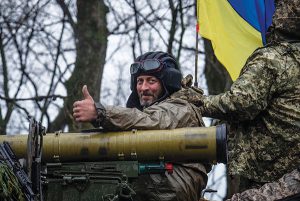Bloomberg
Russia has launched what Foreign Minister Sergei Lavrov hailed as a second phase of the war in Ukraine, and early indications are it could go better for Russia than the first.
After a ferocious night of artillery bombardment along a 300 mile (482 km) front line in the east, Russian forces took a pocket of territory including the city of Kreminna, according to the Ukrainian regional governor.
As a result they threaten to encircle an area at the top of the eastern front that, according to one military analyst, holds as much as 40% of Ukrainian troops in the region.
Columns of tanks and other armoured vehicles were seen heading north from the southeastern port of Mariupol, the besieged city where the last group of defenders are still barricaded in the bunkers of a steel plant.
“If we had access to all the weapons we need, which our partners have and which are comparable to the weapons used by the Russian Federation, we would have already ended this war,†Ukraine’s President Volodymyr Zelenskiy said. “Because the superiority of the Ukrainian military in tactics and wisdom is quite obvious.â€
Already the different terrain, reinforcements and a more traditional combination of air and artillery power appear to have had some impact, with a sharp increase in bombing, missile strikes and artillery fire enabling the initial advance.
With Russia stepping up its bombardment of transport infrastructure across the country, Ukraine’s ability to quickly deliver Western arms 1,350 kms from the Polish border will also be a challenge.
“If the Russians can encircle those troops they will try to bleed them dry of ammo and manpower just like in Mariupol,†said Osint Aggregator, the platform of a military analyst who collects so-called open source data on the conflict, in a Twitter thread. “The Russians have re-opened a southern axis in an
attempt to start that encirclement.†That was a view widely endorsed and celebrated on pro-Russia Twitter and Telegram channels.
But whether Russian forces can succeed in the east where they failed in the north around Kyiv remains an open question, debated among officials and military analysts.
Much of the discussion around timeline has focused on May 9, when Russia marks its victory over Nazi Germany in World War II with an annual military parade, and whether President Vladimir Putin is seeking to be able to declare some sort of win at that point in Ukraine.
UK Prime Minister Boris Johnson told a meeting of cabinet ministers the war was now likely to drag on for months and Ukraine was in a “perilous†position, according to his spokesman, Max Blain.
Despite advantages in troop numbers and fire power, a security official told the cabinet that poor morale and an ongoing piecemeal approach suggested the new offensive would not be decisive, with Russian commanders repeating earlier mistakes, Blain said.
Some military analysts also pointed to the still relatively small number of Russian troops, estimated to be around 80,000, for the scale of the task.
“If this intelligence is right, that Russia has 76 BTGs in Ukraine, it has to be said it’s not a lot to launch a major offensive,†Phillips O’Brien, professor of strategic studies at Scotland’s St Andrews University wrote in another Twitter thread. He was referring to a US assessment that Russia had added another 11 Battalion Tactical Groups, each with about 800 troops when fully manned, to the eastern front, with a further 22 BTGs still being reconstituted.
The Pentagon had upped that assessment to 13 new BTGs introduced, bringing the total to 78. Still, the rush to begin the offensive means that Russia has had to make a rolling start, while its tanks could again struggle to spread off-road for a wider assault, given the muddy conditions likely to continue into May.
The intensity of demands from Ukrainian commanders for nations to quickly deliver the kinds of heavy weaponry needed to resist suggests they are aware that on the more open battlefields of the east, Russia is in a better position to make use of its advantages in air power and long range artillery.
Berlin to offer Kyiv training for artillery, ammunition
Bloomberg
Germany will provide Ukraine with ammunition and training for heavy artillery as chancellor Olaf Scholz comes under pressure to give more support to the effort to fend off Russian forces.
The training and ammunition are for the PzH 2000, a self-propelled, rapid-fire artillery system, which the Netherlands is sending to Ukraine, according to a senior government official.
The training could be provided in Poland or Germany, but not in Ukraine because of ongoing attacks from Russia, said the official, who asked not to be identified because talks between
Nato allies and Ukraine are confidential.
Chancellor Olaf Scholz has come under intense pressure, including from members of his own ruling coalition, to increase military support to Ukraine, including sending heavy weapons.
He told reporters after a video call with G-7 and other Nato allies that Germany has enlisted the country’s defense contractors to help boost
deliveries of weapons to Ukraine after mostly exhausting available stocks from its own armed forces.
 The Gulf Time Newspaper One of the finest business newspapers in the UAE brought to you by our professional writers and editors.
The Gulf Time Newspaper One of the finest business newspapers in the UAE brought to you by our professional writers and editors.
